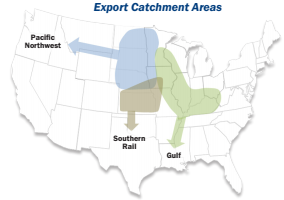II. INTRODUCTION
The U.S. Grains Council 2015/2016 Corn Harvest Quality Report has been designed to help international buyers of U.S. corn understand the initial quality of U.S. yellow commodity corn as it enters the merchandising channel. This is the ffith annual measurement survey of the quality of the U.S. corn crop at harvest. With five years of results, patterns in the impact of weather and growing conditions on the quality of the U.S. corn as it comes out of the field are surfacing.
After a slow start, most of the corn was planted earlier than the 4-year average. The early start to the growing season was followed by heavy rainfall and cool temperatures in the late vegetative and pollination stages, leading to nitrogen fertilizer loss and limited nitrogen uptake. However, favorable weather during the grain filling period created good conditions for crop development, leading to much of the 2015 corn crop having a Good or Excellent crop condition rating. The growing weather set the stage for the second highest yields (just behind 2014), high starch and oil concentrations, and high 100-kernel weight and kernel volume, indicating large kernels. The conditions producing high yields and high starch also led to lower protein, lower true density, and softer endosperm corn in 2015 than in other years.
Warm temperatures and dry conditions hastened corn maturity and natural field drying. This pushed harvest ahead of the previous four years, resulting in little artificial drying and the lowest stress cracks over the past five years. Moistures were also low, and whole kernel percentages were higher than preceding years, which should lead to low breakage susceptibility in handling and good storability. Test weight was higher than the previous three years and 4YA, and BCFM and total damage were low, with averages well within the limits for U.S. No. 1 grade.
These observations show quality differences among the five years, but overall, the 2015/2016 Harvest Quality Report indicates above average quality corn entering the 2015/2016 market channel. 79% of the samples meet all requirements for No. 1 grade, and 94% meet No. 2 grade or better. Average moisture and total damage values show a crop that will store and handle well as it moves through the market channel to export.
Five years of data are laying the foundation for evaluating trends and the factors that impact corn quality. In addition, the cumulative Harvest Report measurement surveys are increasing in value by enabling export buyers to make year-to-year comparisons and assess patterns of corn quality based on crop growing conditions across the years.
This 2015/2016 Harvest Report is based on 620 yellow commodity corn samples taken from defined areas within 12 of the top corn-producing and exporting states. Inbound samples were collected from local grain elevators to observe quality at the point of origin and to provide representative information about the variability of the quality characteristics across the diverse geographic regions.
The sampling areas in the 12 states are divided into three general groupings that are labeled Export Catchment Areas (ECAs). These three ECAs are identified by the three major pathways to export markets:
- The Gulf ECA consists of areas that typically export corn through U.S. Gulf ports;
- The Pacific Northwest (PNW) ECA includes areas exporting corn through Pacific Northwest and California ports; and
- The Southern Rail ECA comprises areas generally exporting corn to Mexico.
Sample test results are reported at the U.S. Aggregate level and for each of the three ECAs, providing a general perspective on the geographic variability of U.S. corn quality.
The quality characteristics of the corn identified at harvest establish the foundation for the quality of the grain ultimately arriving at the export customers’ doors. However, as corn passes through the U.S. marketing system, it is mingled with corn from other locations, aggregated into trucks, barges and rail cars, stored, and loaded and unloaded several times. Therefore, the quality and condition of the corn change between the initial market entry and the export elevator. For this reason, the 2015/2016 Harvest Report should be considered carefully in tandem with the U.S. Grains Council 2015/2016 Corn Export Cargo Quality Report that will follow early in 2016. As always, the quality of an export cargo of corn is established by the contract between buyer and seller, and buyers are free to negotiate any quality factor that is important to them.
This report provides detailed information on each of the quality factors tested, including averages and standard deviations for the aggregate of all samples, and for each of the three ECAs. The “Quality Test Results” section summarizes the following quality factors:
- Grade Factors: test weight, broken corn and foreign material (BCFM), total damage, and heat damage
- Moisture
- Chemical Composition: protein, starch, and oil
- Physical Factors: stress cracks/stress crack index, 100-kernel weight, kernel volume, kernel true density, whole kernels, and horneous (hard) endosperm
- Mycotoxins: aflatoxin and DON
In addition, this Harvest Report includes brief descriptions of the U.S. crop and weather conditions; U.S. corn production, usage and outlook; and detailed descriptions of survey and statistical analysis methods, and testing methods.
New to this 2015/2016 Harvest Report is a simple average of the quality factors’ averages and standard deviations of the previous four Harvest Reports (2011/2012, 2012/2013, 2013/2014 and 2014/2015). These simple averages are calculated for the U.S. Aggregate and each of the three ECAs, and are referred to as “4YA” in the report.
